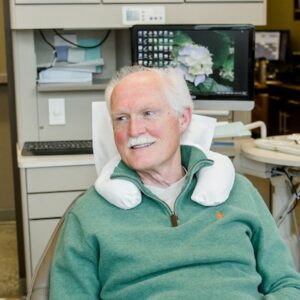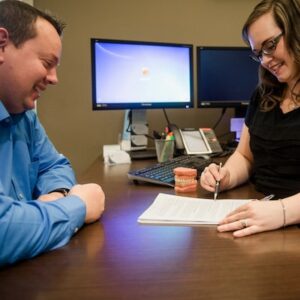Comprehensive Dental Hygiene
Get your routine check-up and a professional teeth cleaning.
ROUTINE HYGIENE WELLNESS
Improve your daily brushing and flossing with Innovative Dentistry
Routine dental hygiene would be started with daily brushing and flossing to remove a great deal of the plaque and bacteria that accumulate on your teeth, but it’s nearly impossible to remove it all on your own.
Your dental hygienist can be your partner in achieving good oral health and visiting the dentist at least twice a year for a professional cleaning can prevent tooth decay and periodontal (gum) disease. Our dentist may recommend more frequent visits based on the condition of your teeth and gums.
What to expect at your check-up appointment:
- Visual evaluation of teeth, face, jaw and neck
- Digital images to check for cavities and other possible problems
- Gum disease evaluation
- Professional teeth cleaning and fluoride treatment
- Screening for oral cancer
How Can We Help?
We provide a range of services to help with your dental hygiene and overall health. Please select an option:
Caring for your Smile
Here is what is included in your typical hygiene appointment.

Visual & Gum Disease Evaluation
During the evaluation, your Seattle dentist will check for cracked, broken, or decayed teeth as well as looking for any abnormal areas on your cheeks, gums, tongue, and roof of the mouth.
Since gum disease affects almost 50% of adults in the U.S. (Center for Disease Control), we perform a comprehensive assessment during your exam to check for any signs of periodontal disease.
When addressed in the early stages, periodontal disease is easily controlled and possibly reversible. Since gum disease exhibits minimal symptoms until it is significantly advanced, it is important to be evaluated for early stages of the disease. Conservative, early intervention is best and our team will assist you in choosing the best treatment options for your condition.

Digital Imaging
The dentist may recommend digital x-rays and photographs to help identify problem areas in your mouth. The type of images may vary based on your particular situation, but a full jaw x-ray, called a panoramic x-ray will give the dentist a comprehensive view of all the structures in your mouth as well as your jaw joint and your sinuses.
Digital 3D imaging may be appropriate in your situation to determine exact positioning of your teeth.
Your dentist may also use a special digital camera to take close up pictures of your teeth or gums. This will help them identify and monitor any areas of concern. We also use intraoral cameras to provide live images of while we examine your smile.


Fluoride Treatment
Cavity Prevention
The American Dental Association (ADA) recommends fluoride treatments based on your risk for developing cavities. Our team evaluates if your risk for cavities is low, moderate, or high, based on criteria outlined by the ADA.
Most individuals with low risk are offered a fluoride treatment twice a year.
Moderate risk individuals are offered fluoride twice a year as well as a take-home fluoride product to help reduce the chance of them getting another cavity.
Individuals with a high risk for cavities may be offered fluoride treatment more than twice a year, a take-home fluoride product, as well as an antimicrobial rinse to reduce the cavity-causing bacteria.

Professional Teeth Cleaning
All of our hygienists are well trained to perform a thorough teeth cleaning. Our team removes the plaque and tartar from your teeth and then polishes them to remove stains and smooth the tooth surface. In addition to hand-held hygiene techniques used by our skilled hygienists, ultrasonic devices deliver targeted treatments to hard to reach areas. These devices deliver ultrasonic vibrations to crush and move calcified deposits of calculus.


Oral Cancer Screening
Development of oral cancer is on the rise. When detected in the early stages, most oral cancers respond very favorably to treatment. The risk of developing oral cancer increases five times with smoking, two and half times with excessive alcohol use and thirty-two times in the presence of a persistent HPV (Human Papilloma Virus) infection.
The dentist will look over all the tissue in your mouth, including your tongue, lips and cheeks, checking for anything abnormal. They will also feel for any unusual lumps or bumps and make recommendations for follow up if necessary. We also have the ability to do a salivary screening to check for an active HPV infection. Recommendations for reducing your risk of developing oral cancer include regular screenings and possible lifestyle changes.
LASERS IN DENTISTRY
Taking your dental care into the modern age.
Lasers have been used in dentistry for several years and provide additional benefits when combined with regular cleanings or therapy for gum disease. There are two specific procedures performed by the hygienists in our offices that can reduce your risk of gum disease or provide improved healing if gum therapy is indicated.
LASER BACTERIAL REDUCTION
Also known as "Laser Decontamination".

A procedure in which thermal, light energy is emitted through a small, fiber optic tip between the teeth and the gums. This energy is used to vaporize the harmful bacteria at or below the gum-line called biofilms.
Biofilms have been shown to be directly related to an increased risk of developing gum disease, a serious infection affecting the supporting bone. During your hygiene appointment, the hygienist will disrupt the biofilm to reduce the risk or severity of periodontal disease, but cannot eliminate the bacteria without the use of the laser. Destroying the bacteria will reduce inflammation in the gum tissue, and keep your gums healthier between visits.
There are no known side effects to laser decontamination. Most patients do not report any sensation during or after the use of the laser. Occasionally, patients will describe a warm, tingling sensation felt during the procedure. Laser decontamination takes approximately 5-10 minutes to complete, and the entire mouth is treated at one time.
The laser uses light energy that is absorbed into the pigmented cell walls of the harmful bacteria, vaporizing them. The bacteria in our mouths that do not contribute to inflammation typically lack pigment in their cell walls and thus are not affected in the same way.
Dental professionals now have access to this technology by using a laser specifically designed to treat the gums. Due to the advances in the production of these dental lasers, our office now has the availability to offer laser decontamination. We are happy to treat our patients with an elevated level of care that is not only supported by years of research but also affordable.
Although the laser kills millions of harmful bacteria at your hygiene appointment, the bacteria will begin to multiply again over time, and will eventually be back to their original levels in a few months. For this reason, we recommend laser decontamination be included every time you see your hygienist. For some patients with a history of periodontal treatment, that is every 3 months. You may be thinking to yourself, “If the bacteria just grow back, what’s the point?”. One of the most important factors in obtaining optimal oral health and control of periodontal disease is your body’s ability to fight off these harmful bacteria. It is true that we are unable to kill the bacteria forever with a single use of the laser, but if it is completed at each appointment, we are able to keep them at a constant lower level, giving your immune system the chance to keep your body healthier.
LASER ASSISTED PERIODONTAL THERAPY
Laser Assisted Periodontal Therapy is a procedure in which thermal, light energy is emitted through a small, fiber optic tip between the teeth and the gums. This energy vaporizes the harmful bacteria at or below the gum-line and removes the infection.
Active periodontal disease is a result of this bacterial infection causing a breakdown of the gums and bone surrounding the teeth. Typically the infected, diseased tissue is removed with a procedure called curettage during gum therapy. It is a non-surgical, conservative procedure performed by your dental hygienist, using a local anesthetic.
Research shows that incorporating the use of the laser into gum therapy procedures “can produce an earlier and greater improvement in gingival health”, and “these applications can be used to improve periodontal wound healing”. The thermal energy produced by the diode laser stimulates circulation and formation of collagen fibers while reducing inflammation and bleeding.
There are no known side effects to incorporating the laser into gum therapy. Most patients report no discomfort during or after the use of the laser. Local anesthetic is utilized for most laser assisted periodontal therapies. It is also recommended to apply vitamin E oil following the therapy to provide a lubricant barrier and additionally promote healing.
Dental professionals now have access to this technology by using a laser specifically designed to treat the gums. Due to the advances in the production of these lasers, our office now has the ability to offer laser-assisted periodontal therapy as part of our standard of care. We are happy to treat our patients with an elevated level of care that is not only supported by the research but also affordable.
Although the laser kills millions of harmful bacteria during the procedure, the bacteria will multiply again over time, returning to original levels over the next several months. For this reason, we recommend laser decontamination therapy be included every time you see your hygienist. For some patients with a history of periodontal disease, this may be every 3 months. One of the most important factors in obtaining optimal oral health and controlling periodontal disease is the body’s ability to fight off these harmful bacteria. Incorporating laser bacterial reduction into appointments following initial gum therapy keeps the bacteria at a lower level, giving the immune system a chance to keep the gums healthier.

I've had a few unpleasant experiences in the past, but they went above and beyond to soothe my nerves and demonstrate great understanding.
I cannot express my gratitude enough!
Staff is always very friendly and professional!
The process of X-Ray they made sure you are comfortable and make it easier.
As someone who doesn't have a good history of dental hygiene it's nice to be treated respectfully and given upfront honest feedback on steps to take.
A professional but caring group!
I immediately called my dentist's office, but they were (understandably) closed for the holiday. I was able to go online and schedule an appointment for the very next morning.
I saw Dr. Wang and she was AMAZING!

How often should I get my teeth cleaned?
The Academy of General Dentistry recommends seeing the dentist for a check-up and cleaning at least twice a year. Your Seattle dentist may recommend you visit more often depending on your specific situation and risk of disease. Some conditions such as diabetes, heart disease, or pregnancy may require more frequent cleanings to keep you and your mouth healthy.

Will my insurance cover my check-up appointment?
Most insurances cover the procedures completed at a check-up and cleaning appointment. Our great team of insurance coordinators will help you navigate through your specific insurance benefits and provide you with an estimate of costs should there be a remaining balance after the insurance payment.


